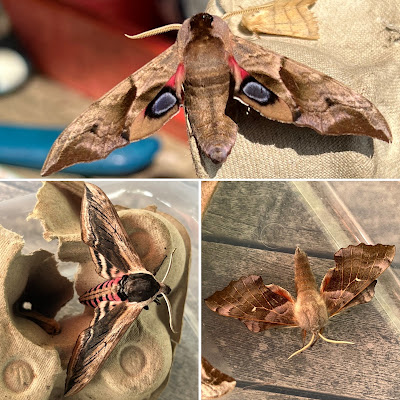Right. After the diversions of our Greek holiday and the Black Hairstreak discovery, it's time to return to the normal subject of this blog, my regular tally of visiting moths. There have been some lovely ones in the last few, warm nights; none new but a great variety and some beautiful species. I'm starting with the Scarlet Tiger, a regular visitor adding colour and fun to the daytime rather than the dark, because it flew unprompted into the house.
Next, a lively pair of male Drinker moths - sexed because of their antennae and smaller size than the paler-coloured females whose caterpillars we used to breed at school. They were easy to find because they climbed long stems of grass in the cool of early evening to sip drops of dew; hence the species' name. These two were preparing to leave and I took this very short clip which shows the classic moth process of warming up the muscles enough for flight.
Finally, this photo includes one of my beautiful thumbs to give you an idea of the Drinker's considerable size. The one below gives scale by the different ploy of showing the moth trap's rainshield in the background, as well as a smaller, 'ordinary-sized' moth slumbering nearby. Plus those terrific antennae and a clearer view of the wing markings, like beads of spilt dew.
The Drinker is almost in the league of the hawk moths which have started to call here every night.Here is a trio of the lovely Eyed, the very familiar Poplar and the socking great Privet, the UK's third-largest moth. An Elephant arrived last week too, but I have seen so many in my mothing time that I lazily neglected to photograph it. Never mind, there will be plenty more.
Here's the Privet Hawk again, below, on a leaf of one of the many Paulownia tomentosa trees which we have grown from seed collected in London and Oxford. My final picture shows views of the wonderful collection of 12 mature Paulownias in the Sir Charles Clore courtyard of the Saïd Business School at Oxford, a hidden glory of the city. Paulownia leaves can grow so big that when a North Oxford primary school used one in a playlet about the Garden of Eden, it hid the whole of both Adam and Eve.







No comments:
Post a Comment